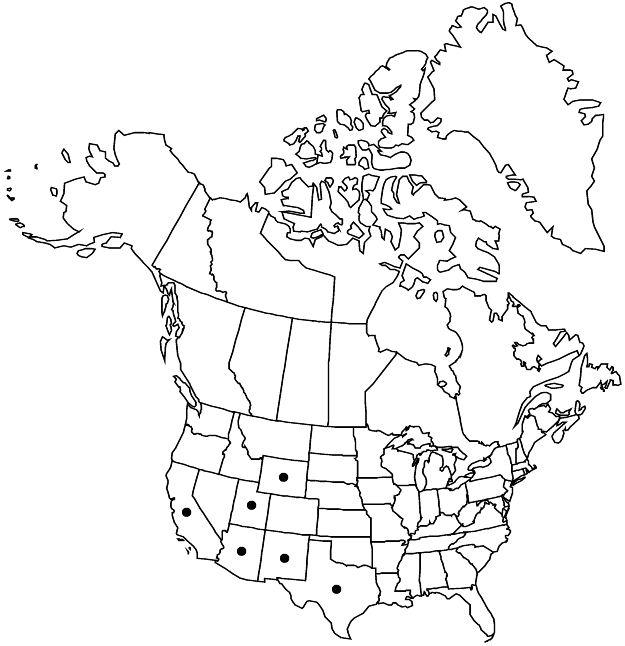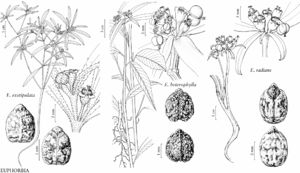Euphorbia exstipulata
in W. H. Emory, Rep. U.S. Mex. Bound. 2(1): 189. 1859.
Herbs, annual, with slender taproot. Stems erect, 5–26 cm, uniformly puberulent to hispidulous or glabrous; branches arcuate. Leaves opposite; petiole 1–3 mm, often indistinct, glabrous or puberulent; blade linear to narrowly elliptic or ovate, 14–42 × 3–28 mm, base attenuate, margins coarsely serrate, occasionally revolute, apex acute to obtuse, abaxial surface sparsely hispidulous to strigillose, adaxial surface glabrous; midvein conspicuous. Cyathial arrangement: terminal cymose or dichasial branches usually 1–2, occasionally reduced to monochasia, 1–2-branched; pleiochasial bracts 2–4, often whorled, wholly green or paler green at base, similar in shape and size to distal leaves or slightly narrower; dichasial bracts similar in shape to distal leaves but smaller or highly reduced. Cyathia: peduncle 1–1.9 mm. Involucre turbinate to campanulate, 1.1–1.5 × 1–1.3 mm, glabrous, pilose or puberulent; involucral lobes divided into several linear lobes; glands 4(–5), yellow to pink, sessile and broadly attached, 0.2 × 0.3–0.4 mm, opening oblong to nearly circular, glabrous; appendages usually petaloid, white to pink, ovate to trapezoidal, occasionally absent, not incurved and covering glands, 0.2–0.4 × 0.3–0.8 mm, entire, undulate, or conspicuously divided into triangular segments, glabrous. Staminate flowers 10–12. Pistillate flowers: ovary puberulent on keels, styles 0.8–1.1 mm, 2-fid 1/2 to nearly entire length. Capsules broadly depressed-oblong to ovoid, 2.7–3.3 × 3.1–3.9 mm, puberulent (with appressed hairs usually concentrated on keels); columella 1.9–2.5 mm. Seeds white to gray or light brown, ovoid, bluntly 4-angled in cross section, 1.9–2.5 × 1.4–1.7 mm, tuberculate, often with 2 transverse ridges; caruncle 0.1 × 0.2 mm.
Phenology: Flowering and fruiting summer–fall.
Habitat: Desert scrub, grasslands, mesquite savannas, oak and oak-juniper woodlands.
Elevation: 800–2000 m.
Distribution

Ariz., Calif., N.Mex., Tex., Utah, Wyo., Mexico (Chihuahua, Coahuila, Durango, Guanajuato, San Luis Potosí, Sonora, Zacatecas).
Discussion
Euphorbia exstipulata is native from Texas to California and northern Mexico. The species was found once in the late nineteenth century in Wyoming but has not been re-collected there. Broad-leaved plants have been segregated as var. lata, but the variation in leaf shape is continuous and no varieties are formally recognized here.
Selected References
None.
